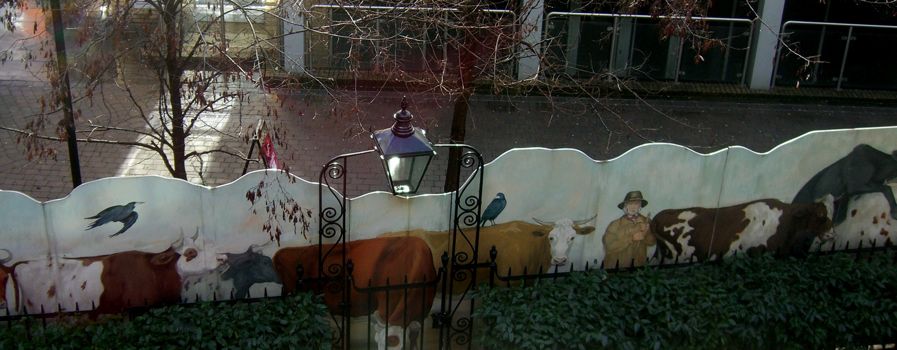

Above: The view from one window of our London hotel, out onto Cowcross Street.
Robert had finance meetings in London that he needed to schedule sometime in February or March, and my spring break was coming up the second week in March, so we decided to take a trip to London together—I hadn’t been to England since a trip with my parents twenty-five years ago, and both Robert and I wanted a little bit of a luxurious, crazy vacation. On Friday, March 7th, we had a nice dinner out in Chinatown and saw the (laughably bad) movie “10,000 BC” with Jef, Jin Yoon, and Basil.
Then Saturday we got up late (Robert still sniffling and coughing from the remnants of a cold) and had brunch at Tremont 647 in the South End—gingerbread pancakes, momos, bacon grilled cheese sandwich with tomato sauce, and a homemade pb&j pop-tart. At 5:00 we made our way to the airport, for our Virgin Atlantic “Premium Economy” (sort of their business class—six more inches of legroom and nicer food than economy, for only $100 more round-trip per person) flight to London.
It had been raining in Boston all day long, though, and the plane was somewhat delayed arriving, so we took off a little over an hour late—filling part of our waiting time by eating mediocre food with bad service at the Houlihan’s right in the terminal. The highlight of that meal was watching the Brit at the table next to us react to those crazy Americans, who offered him white Zinfandel when he asked for a white wine. He agreed, and then sent it back, saying, “I asked for a white wine. This is not white. Can I see a proper wine list?” “I bet he can’t,” said Robert, and soon the man was handed one of those table-trees—a proper wine list if he ever saw one, I’m sure.
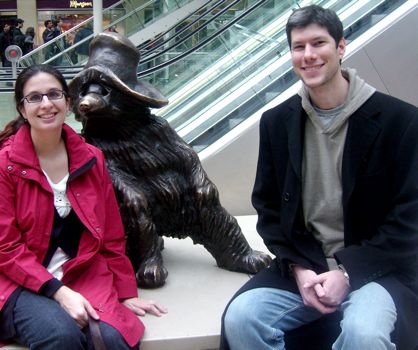 When
we finally got on the plane, the pilot made a big point of stressing that because
of the winds, though, we were going to make up time—Robert commented that
the pilots sounded pretty smug indeed when they pointed out that we ended up
landing at Heathrow right on time. The flight was very bumpy at first, because
of the bad weather around Boston, and we discovered that Virgin Atlantic flight
attendants are for some reason quite Nazi-like about not allowing blankets on
your lap during take-off or landing—“Safety issues,” they
say, waking me up to remove it. “In the event of an emergency, you could
trip on the blanket.” Yeah, whatever. (“Why have terrorists made
it harder for us to stay warm during take-off?” Robert asked plaintively.
“I’m sure it’s their fault somehow.”)
When
we finally got on the plane, the pilot made a big point of stressing that because
of the winds, though, we were going to make up time—Robert commented that
the pilots sounded pretty smug indeed when they pointed out that we ended up
landing at Heathrow right on time. The flight was very bumpy at first, because
of the bad weather around Boston, and we discovered that Virgin Atlantic flight
attendants are for some reason quite Nazi-like about not allowing blankets on
your lap during take-off or landing—“Safety issues,” they
say, waking me up to remove it. “In the event of an emergency, you could
trip on the blanket.” Yeah, whatever. (“Why have terrorists made
it harder for us to stay warm during take-off?” Robert asked plaintively.
“I’m sure it’s their fault somehow.”)
We arrived at Heathrow around 7:30 in the morning and walked what feels like a mile through the terminals until we finally get to the customs area. After a half hour wait, we presented out landing cards and passports. “How do you two know each other?” the official asked. “We met at a dance,” Robert said. The woman found him charming, and we were ushered through, down to the baggage “reclaim” area—as those crazy Brits call it. We’d had to check two rolling suitcases because we each had another carry-on, but we could literally see my suitcase on baggage return #6, all the way across the room from when we entered. My favorite red rolling suitcase was mauled on the way back from Colorado in January (one sturdy wheel essentially torn off), so since it was only a $30 bag from Target three years ago, I set out to replace it. Annoyingly, I couldn’t find an exact replacement anywhere (the great things about that bag were its much larger wheels than normal on rolling suitcases, which allowed me to drag it up and down curbs without worry, and the wider base and narrower top, which both allowed it to not overbalance when full but also to fit more efficiently in airplane overhead bins), so after some research I decided to get a lime green “Dash” suitcase from Brookstone. The Dash is great—hard-sided, so rain, sleet, and snow don’t hurt it, and with four wheels instead of the standard too, for very easy rotating. Also, I don’t think there was another lime green suitcase in the entire terminal, which made it easy to spot. Robert’s boring black bag appeared soon after, and we headed straight for the Heathrow Express train into the city.
The Heathrow Express took
just fifteen minutes (just enough time to eat a tangerine I’d brought
with us) and put us right at Paddington Station, which was convenient for snapping
a quick Paddington Bear picture as our first stop in London. We then took a
cab to our hotel, the Rookery, just a block from the Farringdon Tube in the
Clerkenwell district. Both the information desk woman at the Paddington Station
(whom we asked for maps) and the cabbie were puzzled at our choice of hotel,
remarking that they’d never heard of anyone staying “over there”
before. I explained each time that it’s an interesting, character-full
hotel which happens to be rather centrally located for finance 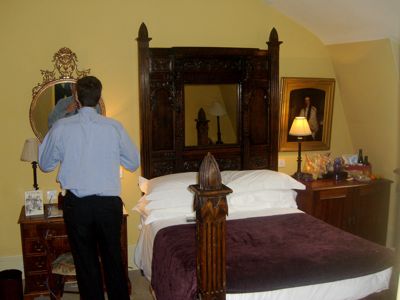 meetings
in “The City” (aka, downtown or the financial district).
meetings
in “The City” (aka, downtown or the financial district).
We arrived at the hotel around 9:30 and checked right in. Robert was not impressed by the walk up to our room on the third and top floor, but I pointed out we climb more stairs to our apartment everyday. Though the hotel offers LCD TVs, DVD players, and free wireless Internet access (not to mention air conditioning!), they (obviously) did not install an elevator and they furnish all rooms and bathrooms with nineteenth-century furnishings. Our room had a peaked ceiling, a Victorian tub with an extremely high shower head, and a Victorian toilet that spat when you flushed (just close the lid first and you’ll be fine). “Oh look,” said Robert, staring at a bust above the doorway. “There’s a head in our bathroom. And great—one of those sinks with separate hot and cold water faucets!” Ignoring his sarcasm, I assured him that I knew, and I was also suitably impressed. (For the record, by the end of the week Robert agreed that the hotel was very nice, the shower excellent, and the bed comfortable.)
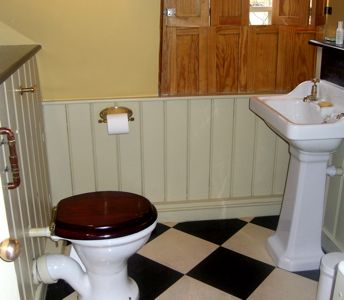
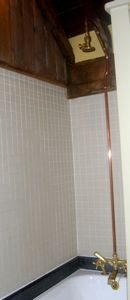
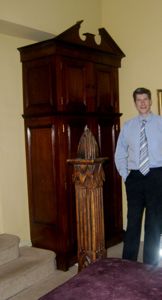
Around 11:00 we closed the shutters and took a three-hour nap. At 2:00 we got up and took the tube to Piccadilly (changing at King’s Cross, while Robert munched an apple from the hotel). On the tube, a woman got on and looked confused. “Does this go to Piccadilly?” she asked the woman sitting next to her. Now that woman seemed confused, and together they squinted at the map and tried to talk through things. “Yes,” I said from across the aisle, but was ignored. “Yes, it goes to Piccadilly. It’s like three more stops.” The women thanked me and settled back down. Robert teased me: “Oh, stop being such a New Yorker—one of those know-it-all helpful New Yorkers.” I pointed out that there were actually infinite questions about directions on the tube that I couldn’t answer, but only a few that I could. I came up with four questions that I was capable of answering:
So therefore, being asked one of only four questions I knew the answer to—actually had the information—why wouldn’t I answer? I also couldn’t figure out what was wrong with the obviously English woman who didn’t know the train was headed to Piccadilly. Bostonians, it was as though someone got on the T at Kenmore, heading inbound, and asked a random person, “Does this train go to Park Street?” Yes, the answer is yes. You don’t have to think about it. You don’t have to look at the map. Even if you always get off at Arlington, you just know the train goes to Park Street. Really, it’s not that hard!
In Piccadilly we walked
west, stopping at a Japanese sushi/bento/grocery store to buy an onigiri and
at Minamoto Kitchoan (cute, but smaller than the Manhattan branch, and Robert
was struck in the head by a falling table-sized umbrella that a woman knocked
into him) for one of those mochi  ball
skewers. Thus fortified we poked through Fortnum & Mason. “What’s
wrong?” I asked Robert when he checked his watch just after we passed
the wall of teas and before we hit the wall of chocolates. “Oh, nothing,”
he said. “I just thought we’d been in here for more than. . . thirteen
whole minutes.” We left without buying anything, and walked down through
St. James Park and Pall Mall toward Parliament. In the park, as I hummed “Bustopher
Jones” (“In the whole of St. James’s / the smartest of names
is / the name of this brummel of cats. / It was and it shall / be spring in
Pall Mall / while Bustopher Jones wears white spats.”), we bought a vanilla
ice cream with a Cadbury flake bar—a great combination I remember from
England as a kid.
ball
skewers. Thus fortified we poked through Fortnum & Mason. “What’s
wrong?” I asked Robert when he checked his watch just after we passed
the wall of teas and before we hit the wall of chocolates. “Oh, nothing,”
he said. “I just thought we’d been in here for more than. . . thirteen
whole minutes.” We left without buying anything, and walked down through
St. James Park and Pall Mall toward Parliament. In the park, as I hummed “Bustopher
Jones” (“In the whole of St. James’s / the smartest of names
is / the name of this brummel of cats. / It was and it shall / be spring in
Pall Mall / while Bustopher Jones wears white spats.”), we bought a vanilla
ice cream with a Cadbury flake bar—a great combination I remember from
England as a kid.
I joke that apparently I
have to go back to England every twenty-five years, but really I’d like
to go back slightly sooner than that, actually. If for no other reason, we have
to take our Arthurian vacation (in five to ten years or so) with a child and
my parents to act out the various legends. Still, I’d pulled out my journal
from my first trip before we left this time (“Wow, I had no idea that
was a vintage 1983 Pac-Man notebook there,” Robert joked) and pawed through
my stash of coins—apparently, pence are no longer labeled “new pence”
nowadays, and shilling coins—still 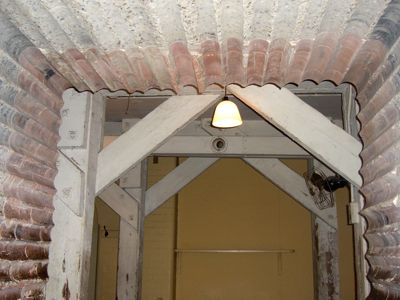 common
in 1983, even twelve years after decimalization—are basically non-existent.
common
in 1983, even twelve years after decimalization—are basically non-existent.
Back in 2008, though, we enjoyed the sunny afternoon and made our way to the Churchill Museum and Council War Rooms on the eastern edge of St. James Park. We loved the museum, even though we had both anticipated (wrongly) that the audio tour would be cheesy. “How in the world did this never get bombed?” Robert asked, after we learned that the war rooms—built underneath various government buildings, just a block from Whitehall Street and Downey Street—couldn’t sustain a direct hit from any German bomb. At left, you see how they did protect at lesat one room which was particularly liable to bombs: they filled it in completely with concrete and then actually drilled out the opening for the room. We learned more than we’d ever known about Churchill and his wife (Clemmie), and walked through the museum until around 5:30.
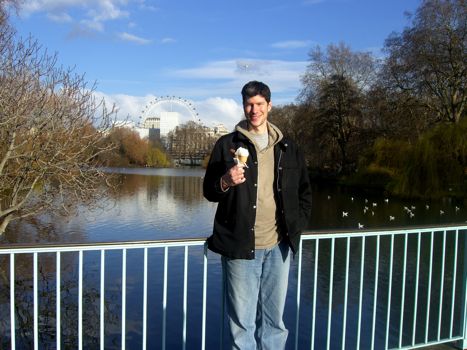 At
that point, in a light drizzle, we walked up Whitehall Street past the Women
in World War II monument—which sadly was on the other side of a construction
fence, as they’re installing new water mains under the road, and so was
hard to get a better shot of—back through Trafalgar Square and Piccadilly
toward some supper. We were aiming for Mother Mash on Ganton Street, north of
Piccadilly in Soho, but even though the website said they were open until 7:00
on Sundays, they were completely closed at 6:00 (with no explanation or revised
opening hours posted) when we got there. Exhausted, dehydrated, and starving,
we turned to the
At
that point, in a light drizzle, we walked up Whitehall Street past the Women
in World War II monument—which sadly was on the other side of a construction
fence, as they’re installing new water mains under the road, and so was
hard to get a better shot of—back through Trafalgar Square and Piccadilly
toward some supper. We were aiming for Mother Mash on Ganton Street, north of
Piccadilly in Soho, but even though the website said they were open until 7:00
on Sundays, they were completely closed at 6:00 (with no explanation or revised
opening hours posted) when we got there. Exhausted, dehydrated, and starving,
we turned to the 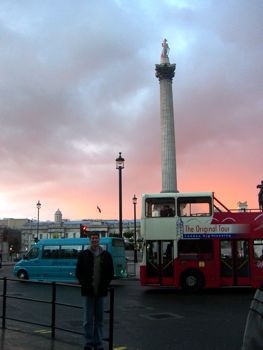 Thai
restaurant immediately across the street, Mangosteen, and decided to let fate
decide our evening meal. We actually had a fabulous meal from a menu filled
with unusual selections (a pad Thai dish wrapped up in a Thai omelet? Intriguing,
but we didn’t quite have enough stomach space). We ate an egg bomb (fried
eggs with minced pork, tamarind, onions, and chili—classic Thai street
food that I’d seen recipes for but never seen on a restaurant menu) with
rice and a jungle-style curry (no coconut milk, just more tamarind—but
actually a very different flavor profile) with really good cabbage and with
a whole deep-fried sea bass cut into chunks. For dessert, from their extensive
and delicious-looking dessert menu, we had a pandan crepe filled with fruit
and served with coconut ice cream, and the classic mango with sticky rice and
coconut milk. Everything was great, and we were completely satisfied when we
took a cab back to the hotel around 8:15.
Thai
restaurant immediately across the street, Mangosteen, and decided to let fate
decide our evening meal. We actually had a fabulous meal from a menu filled
with unusual selections (a pad Thai dish wrapped up in a Thai omelet? Intriguing,
but we didn’t quite have enough stomach space). We ate an egg bomb (fried
eggs with minced pork, tamarind, onions, and chili—classic Thai street
food that I’d seen recipes for but never seen on a restaurant menu) with
rice and a jungle-style curry (no coconut milk, just more tamarind—but
actually a very different flavor profile) with really good cabbage and with
a whole deep-fried sea bass cut into chunks. For dessert, from their extensive
and delicious-looking dessert menu, we had a pandan crepe filled with fruit
and served with coconut ice cream, and the classic mango with sticky rice and
coconut milk. Everything was great, and we were completely satisfied when we
took a cab back to the hotel around 8:15.
While Robert fussed with his computer and the wireless (not too surprisingly, Crystal, my two-year-and-seven-month-old iBook saw the network right away and connected automatically, but Robert’s Dell had trouble staying on the network with or without a username and password from the front desk), I immediately fell asleep. I think Robert stayed up until midnight or so, thereby making a valiant effort to get himself on a London schedule (say it /sh/ not /sk/) in time for his first business meeting.
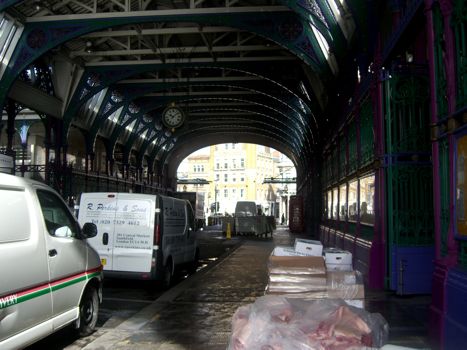 I
woke up at 3:00 in the morning, wide awake, and could not fall back to sleep.
I liked that the sounds of the rain and wind outside were almost a match for
the sounds of rain and wind in our also top-floor apartment in Boston, but I
just wasn’t tired. Around 4:30 I gave up lying in bed and got up, washed
up, and then turned on Crystal and read the paper and various tourist websites
until 8:00, when Robert finally got up.
I
woke up at 3:00 in the morning, wide awake, and could not fall back to sleep.
I liked that the sounds of the rain and wind outside were almost a match for
the sounds of rain and wind in our also top-floor apartment in Boston, but I
just wasn’t tired. Around 4:30 I gave up lying in bed and got up, washed
up, and then turned on Crystal and read the paper and various tourist websites
until 8:00, when Robert finally got up.
At 9:00 we went to the Zetter, just a few blocks away, for breakfast—Robert had the classic English breakfast with continental buffet, and I had the vegetarian breakfast with the same buffet. Highlights were the perfectly poached eggs, the thick sourdough toast, the good tea and coffee, the stewed tomatoes and thick mushrooms that came with both our meals, Robert’s breakfast sausage, my sauteed spinach and half an avocado, the pineapple juice, the cute little glass pots of yogurt, the house-made granola with dried fruit, and the thick whole-grain bread with strawberry jam. By the end of breakfast it was sunny, and Robert squinted in the sun as we walked down past our hotel to Smithfield Market just a couple blocks away. Smithfield Market (above left) is still London’s thriving poultry and meat market, but at 10:00 all we saw were some cleaners hosing things down and a few last flats of ducks and slabs of beef, packaged up and waiting to be loaded up onto trucks—er, lorries. We read the historical signs, admired the colorful open ironwork, and remarked on how impressed we were at the complete and utter lack of any smell—far better than the Haymarket/halal meat markets in Boston, and clearly much fresher.
Then we headed back to the hotel so Robert could fuss with the Internet again, get changed, and head over to his first meeting of the trip. While he finally connected with a primitive ethernet cable supplied by the front desk, I took a one-hour nap. At 12:30 we both left, him for a cab for his meeting and me for a short walk to the Dickens House Museum.
It took less than fifteen minutes to walk there, even including my terrible English street-crossing skills. Somehow I just can’t seem to get the hang of looking in the right direction, given how backwards all the traffic is. The fact that some streets have helpful “Look Left!” or “Look Right!” directions printed on the ground in the crosswalk doesn’t help me either—I need a helpful “Look Down!” sign ahead of me to remind me to look down to read the directions at my feet. I think the problem I’m having is a little like having a dominant leg when skiing, when turns to one side just go much more smoothly and naturally, and you always have to force it and think about it when turning to the other side. I only got almost run over twice, though (once on the way to the Dickens House and once on the way back)—and once was by one of those insanely fast motor scooters, while the other was by a van making one of those giant English U-turns on streets you’d think were too narrow to allow it.
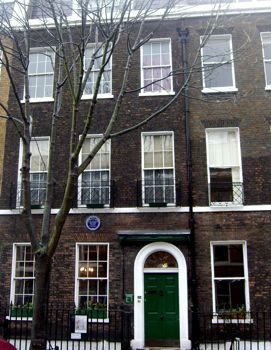 The
Dickens House was great, of course. It’s a little more like the Lucy Maud
Montgomery Birthplace house rather than, say, the Edgar Allan Poe House or the
Alcott House—very few of the furnishings are native to the house when
Dickens lived there, though more of the furnishings came from his other (now
demolished) houses, and most of the rooms are set up not as rooms the way they
would have looked in the 1830s, during the writing of Oliver, Pickwick, etc.,
but rather as museums crammed full of random bits of photos, letters, books,
and paraphernalia. I loved it. The street it’s on looks completely unremarkable—just
a standard street of connected brick row houses—and I initially had trouble
finding it because I can’t get used to the English habit of having even
and odd numbers on the same side of the street: I turned on the street, saw
the number 61 on my right, and immediately crossed, only to then find the numbers
3, 4, etc. and then cross back to find number 48 Doughty Street. At the end,
in the little gift shop, I went mildly crazy and bought a first-edition copy
of The Life of Our Lord by Dickens—it’s the story of Jesus’s
life that he wrote for his own children when they were young, and read them
in manuscript for years, which was only published once years after his death.
The bookstore/gift shop is tiny, and though they knew it was a first edition,
a) it’s almost certainly the most minor Dickens work ever, which doesn’t
fit in thematically with any of the other exhibits in the house, and b) the
store clearly doesn’t have much call for items priced much higher than
post cards or commemorative posters, so the book had already been reduced in
price twice. I agonized over it and finally decided to get it—it’s
in good condition, and even considering the terrible exchange rate, it’s
cheaper than the cheapest copy we ever had at Heritage (when we’d get
them in occasionally), and it’s likely my only chance ever to have any
Dickens first edition at all.
The
Dickens House was great, of course. It’s a little more like the Lucy Maud
Montgomery Birthplace house rather than, say, the Edgar Allan Poe House or the
Alcott House—very few of the furnishings are native to the house when
Dickens lived there, though more of the furnishings came from his other (now
demolished) houses, and most of the rooms are set up not as rooms the way they
would have looked in the 1830s, during the writing of Oliver, Pickwick, etc.,
but rather as museums crammed full of random bits of photos, letters, books,
and paraphernalia. I loved it. The street it’s on looks completely unremarkable—just
a standard street of connected brick row houses—and I initially had trouble
finding it because I can’t get used to the English habit of having even
and odd numbers on the same side of the street: I turned on the street, saw
the number 61 on my right, and immediately crossed, only to then find the numbers
3, 4, etc. and then cross back to find number 48 Doughty Street. At the end,
in the little gift shop, I went mildly crazy and bought a first-edition copy
of The Life of Our Lord by Dickens—it’s the story of Jesus’s
life that he wrote for his own children when they were young, and read them
in manuscript for years, which was only published once years after his death.
The bookstore/gift shop is tiny, and though they knew it was a first edition,
a) it’s almost certainly the most minor Dickens work ever, which doesn’t
fit in thematically with any of the other exhibits in the house, and b) the
store clearly doesn’t have much call for items priced much higher than
post cards or commemorative posters, so the book had already been reduced in
price twice. I agonized over it and finally decided to get it—it’s
in good condition, and even considering the terrible exchange rate, it’s
cheaper than the cheapest copy we ever had at Heritage (when we’d get
them in occasionally), and it’s likely my only chance ever to have any
Dickens first edition at all.
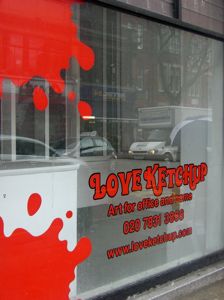 I
walked back to the hotel in the alternating drizzle and sunshine, clutching
my bag to be sure the book didn’t get wet, and reflected that the weather
in London in the beginning of March seems to be exactly comparable to the weather
in Alaska in the end of August, oddly enough. At left, you see a random art
gallery I passed: we have enough friends who do love ketchup that I
thought it would make a fun picture.
I
walked back to the hotel in the alternating drizzle and sunshine, clutching
my bag to be sure the book didn’t get wet, and reflected that the weather
in London in the beginning of March seems to be exactly comparable to the weather
in Alaska in the end of August, oddly enough. At left, you see a random art
gallery I passed: we have enough friends who do love ketchup that I
thought it would make a fun picture.
Forty-five minutes later, Robert arrived back from his meeting (reporting that the highlight was the cucumber sandwiches and the cucumber-seafood salad sandwiches on the lunch tray) and proceeded to break our Internet access completely. After many calls to the front desk and visits from a helpful not-completely-incompetent tech guy/bell boy and promises to reset their router (“rooter,” he called it in his continental way), ultimately Robert went back to using the wired connection, just like he had been using this morning, and the wireless connection that I’d been using disappeared entirely. For good.
We gave up and at 4:15 took a cab to the intersection (“That appears to be a difficult word for people here,” Robert observed. He’s since learned to say “junction.”) of Cheshire and Brick Lane because Robert wanted to walk through the Bengali section of town and browse and nibble.
Our first stop was at the two famous beigel shops (“They have to misspell it or everyone here would mispronounce it as a ‘baahgal,’” said Robert). We vacillated between the two, finally following a young man into one. He ordered one plain beigel. “Just one?” complained the stout woman behind the counter. “Okay, three,” the guy said. When it was our turn, Robert started his normal “What’s-fresh-out-of-the-oven?” routine, with approximately the same results as we get in a typical Chinese bakery: everything we point at is hot, even if it’s not. I zeroed in on the “onion platzel” on the menu, and asked what it was, since I figured it was related to a bialy but I couldn’t actually see anything that looked like one. “There,” the woman said, gesturing unhelpfully at the entire bakery display. When we persisted, she finally moved a tray so we could actually see the platzels, then punched one with her hand. “Hot!” she said. Robert was sold. We ordered one platzel. “No more?” she prompted. Nope, sorry. We paid for our platzel, which was indeed like an extra flaky-crusted bialy, chewy and good, though not as chewy nor as good as the typical ever-harder-to-find New York bialy. Oh, and by the way—it wasn’t warm.
In alternating drizzle and clouds, we walked the entire length of Brick Lane, looking at all the restaurant menus, going into all the halal fast food places and Bengali cafeteria places, and browsing through two Bengali supermarkets (I bought dried lime slices, which are hard to find in Boston). We stopped at Rajmahal Sweet Shop on a corner, since I’d read that that was the best place for sweets, and bought some barfi, a milk sweet, and a gulab jamun. Two doors down, though, there was actually a nicer sweet shop—everything seemed fresher, the guy was much friendlier, and all of the sweets were half the price (literally) of the previous place. We bought a hot samosa there—it was genuinely hot, fresh out of the fryer—and wished we’d come there first for the sweets too.
A block from the end of Brick Lane, we chose Bengal Cuisine as our restaurant of choice for dinner and went in at ten to six. They advertise a “Cook Your Own Curry” combination of cooking class and fixed-price dinner on Sunday and Monday nights from 6:00 to 9:00 for 25 pounds a person.
We sat down and got bottled water (“Free! Free! Include!”) and a plate of papadums with a chutney tray. One of the chutneys was a yogurt-based mango chutney that tasted for all the world like a thinned-out mango lassi—I could not stop eating it, it was so delicious.
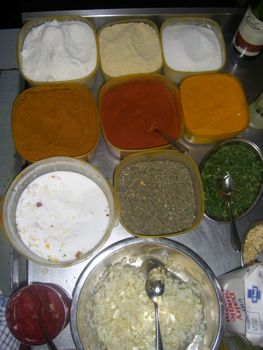

Then we each chose an appetizer, meat/chicken dish, vegetable dish, and rice from the menu. Robert had a lot of advice for optimizing dish choices based on tastiness, excitingness of cooking process, and price—I ignored him and just chose my own dishes without agonizing, and we ended up with a very good selection. And, since our meal (with water, chutney, and papadums) totaled 48 pounds, we figured it was a pretty good deal after all. We ended up getting a king prawn curry that gets placed on a poori, a chicken chaat appetizer, a chicken main course with a Bengali lemon-like fruit, lamb with Kabocha squash, aloo gobi, saag paneer, coconut rice, and mushroom rice pilau.
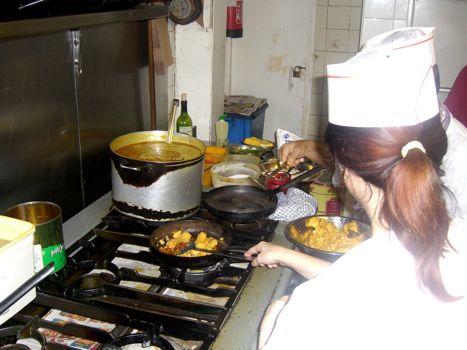
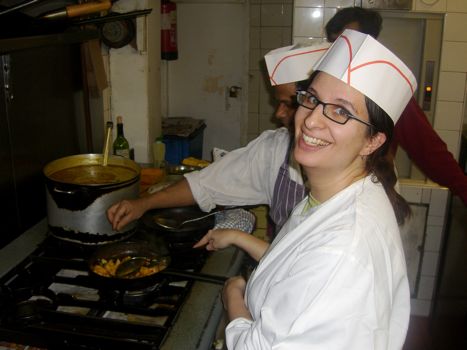
After a little while we were brought paper hats and chef shirts and were summoned downstairs into the kitchen. The head waiter guy came with us and acted as a commentator/interpreter (though note that his English was not all that great itself) and the main chef and the deep-frying chef took turns demonstrating things and letting us do them. We really did make each dish, poori and all, and then there was a period of questions and answers and they ran back over the recipes and gave me a clipboard in case I wanted to take notes. It was odd and thrilling, and a truly foreign experience. Robert had no idea what anyone was saying at any point, he claims, and often his questions did not exactly get answered in any sort of useful way, but we both had a great time. We spent about forty-five minutes in the kitchen, and then they sent us back up while they plated up and garnished the food and brought it upstairs (they really like their dumbwaiters in that place). The most interesting dish we made, really, was saag paneer, which began with one hefty part coconut powder (maybe 1⁄4 cup or so) and one equal part almond powder plus one-third part sugar in a frying pan. Then broth, spinach, cheese cubes, and light cream were added, but it was really the coconut powder, sugar, and almonds that I was completely surprised by. Upstairs, it finally dawned on Robert that we had way too much food in front of us, and we weren’t able to eat even half of what was there. This entire time, we only saw one other person in the restaurant, and he entered after we were served our meal, so the restaurant wasn’t lying when they said this was their slow period. It really did seem to be a creative use of their space during the slower times, and we wish more restaurants would do something like this. I’d highly recommend this experience to anyone, really.
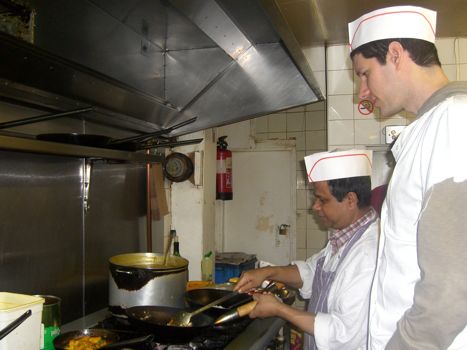
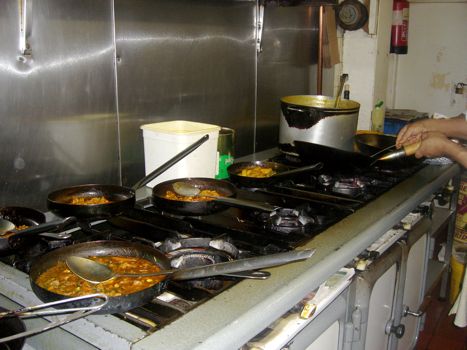
After dinner, we walked part of the way home and took a cab the rest of the distance. Then, since we didn’t have a refrigerator, we gave our leftover food (neatly packaged up) to the hotel’s tech guy/bellboy when we ran into him on our way in, and he said he or one of the other guys on night duty would be very happy to eat it.
We got home at 8:15 and I fell asleep at 9:00. Robert stayed up until almost 1:00, though, when his process of getting ready for bed woke me up with a start. I then got up, took a shower, and went back to bed.
We both woke up at 9:00,
and Robert had to hustle to get to his 10:30 meeting. We ate some cold cereal
and bananas in the room and then left a little after 10:00. I took the tube
to Knightsbridge and walked through Harrods, with my main destination their
food halls. Oh, what a gorgeous place! I bought us enough things for an interesting
and fun picnic lunch, since our plan was to meet at noon at the main entrance
of St. Paul’s Cathedral (right near Robert’s meetings) and have
lunch together in between his morning and afternoon appointment. Carefully carrying
my packages, I bought some little things for Aurora, Yasmine, and Grandma Helena
on my way out and then took 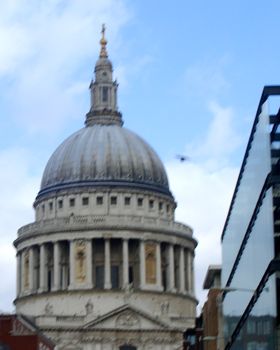 the
tube to St. Paul’s.
the
tube to St. Paul’s.
Once there I listened in on several guides giving mini-presentations to their tour groups, I avoided the sudden gusty rain showers that would pop up and then go away, and I made a Singaporean friend as we both walked 355 degrees around the church to try to find the main entrance. When Robert came and met me, it was once again drizzling, so sitting on the steps to eat was out. We huddled over a stone pylon and then moved under a nearby overhang when the rain got a little worse. We dined on: one harkow (they call them “crystal prawn dumplings” here), one “Chinese samosa,” one shrimp toast, one Scotch egg (quite good!), one lamb and potato pie topped with red currants, one slice of spinach and cheese quiche, a lychee juice, a Sicilian lemonade, and a stoneware pot of creme caramel (miraculously sold, for just 99 pence, right next to the yogurts). Everything was great except our accommodations.
We decided against climbing
to the top of the dome because Robert had his large rolling briefcase with him,
and that would have been rather cumbersome on the stairs. Instead, we walked
south (the rain now having let up, but the wind still quite strong) and headed
across Millenium Bridge to the Tate Modern. We chose a floor at random to start
and when we stepped out of the elevator were greeted by a humorous sight. I
had just been complaining about the unfortunate coincidence that led me to be
wearing all red today: my winter pocketbook happens to be red (Marnie bought
it for me for Christmas), my three-quarter-length raincoat is red (it was that
or tan or navy, so I chose the most interesting color available), my emergency
tote bag now containing the Harrods souvenirs is red (it’s a neat design
with a black cat on one side, and I’d bought one for me and one for Aurora,
on sale, a year ago), and by chance I was wearing the only red top I own. Beyond
the elevators, on the fifth floor, all 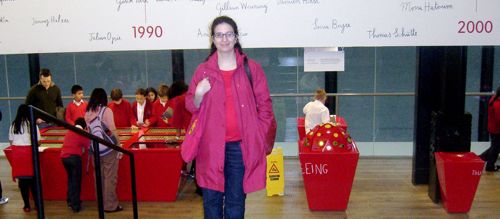 we
saw was more red: there were kiosks and interactive displays, all painted a
shiny bright red, and an entire class of schoolchildren on a trip—all
wearing matching bright red sweaters. Robert took a picture of me in front of
all the red.
we
saw was more red: there were kiosks and interactive displays, all painted a
shiny bright red, and an entire class of schoolchildren on a trip—all
wearing matching bright red sweaters. Robert took a picture of me in front of
all the red.
I was extremely tired of walking and standing at that point, since I’d been standing nonstop since leaving for Harrod’s at 10:00, so we moved kind of slowly around the rooms, stopping often at the film displays and the nice benches. It’s a good museum, but I’m not quite sure why people rave about it so much. It’s approximately the same size as the Guggenheim, as far as I can tell, and we saw an interesting range of items, but by 2:20 we were pretty much done.
It was actually sunny at
this point, shockingly, with a little bit of blue sky peaking out from behind
the buildings, and Robert walked to his next meeting and I went back to the
hotel. When he came back (having gotten lost and walked rather far out of his
way) he brought a snack—a salmon onigiri and two individually wrapped
(!!) salmon nigiri 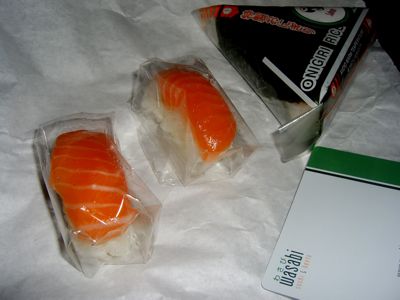 from
a sushi and bento place he passed along the way. We then relaxed and napped
until 7:00, when we hopped back on the tube and went to dinner at Mother Mash.
I had a boxty mash bashed (chunky mashed potatoes with cheese and scallions)
with beef-Guinness sausages and a farmer’s gravy (with red wine, mushrooms,
and bacon). Robert had a mustard mash with a steak pie and an onion gravy, and
we split a sticky toffee pudding with custard sauce for dessert. It was a great,
classic British meal in an appealing little place, and it was fairly cheap too.
After dinner we walked for about an hour down Regent Street, then through Piccadilly,
into a mall there, and over to Covent Garden. We went into a British candy store
and ogled (and sampled) the many different kinds of marshmallows and strange
and innovative candies and we stopped in a Marks and Spencer to buy milk, juice,
muesli, and a Dalek chocolate lollipop as a little gift for Bob. From Covent
Garden we took the tube the rest of the way back to our hotel, getting in around
10:30—our latest night out yet!
from
a sushi and bento place he passed along the way. We then relaxed and napped
until 7:00, when we hopped back on the tube and went to dinner at Mother Mash.
I had a boxty mash bashed (chunky mashed potatoes with cheese and scallions)
with beef-Guinness sausages and a farmer’s gravy (with red wine, mushrooms,
and bacon). Robert had a mustard mash with a steak pie and an onion gravy, and
we split a sticky toffee pudding with custard sauce for dessert. It was a great,
classic British meal in an appealing little place, and it was fairly cheap too.
After dinner we walked for about an hour down Regent Street, then through Piccadilly,
into a mall there, and over to Covent Garden. We went into a British candy store
and ogled (and sampled) the many different kinds of marshmallows and strange
and innovative candies and we stopped in a Marks and Spencer to buy milk, juice,
muesli, and a Dalek chocolate lollipop as a little gift for Bob. From Covent
Garden we took the tube the rest of the way back to our hotel, getting in around
10:30—our latest night out yet!
Not too surprisingly, Robert (again) had trouble getting up in the morning, and didn’t have time for more than half an apple and a glass of the lychee, apple, and strawberry juice in the room before dashing out to a cab to his 9:00 meeting. I got ready more leisurely after he left, and at 10:30 went to check out a bookstore a few doors down from the hotel which was going out of business—everything in the store was at least 75% off. For me, that meant that if I just took half of the undiscounted price in pounds and assumed that was the price to me in dollars. I bought some neat books for people for Christmas, and then I also bought half a dozen kids’ books for us (three about Christmas and three just random ones). Robert, I’m sure, thinks I went a little crazy, and wasn’t happy about lugging these books home in our suitcase, but I feel like you can always find room for a few more books somewhere.
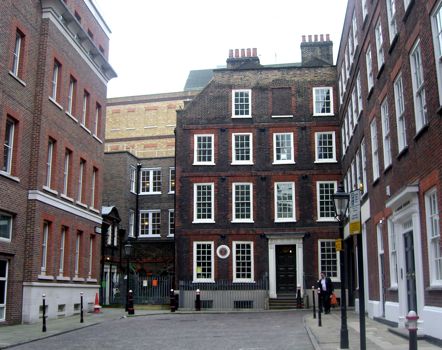 I
left my books behind the “till” and went on to the Samuel Johnson
house, which was actually just barely a five-minute walk from the hotel. Fittingly,
since Johnson moved there during the composition of the dictionary in order
to be closer to his printers, you have to turn down Printer’s Lane in
order to turn onto Gough Square (his actual street). The house is restored to
essentially what it looked like during Johnson’s day (ca. 1750). One interesting
thing I learned was that the house was damaged three separate times in the WWII
bombings of London; after the first time, the curator at the time (a woman who
lived next door to the house with her daughter, and mother, and who was all
alone when the house was damaged the first time) became very smart about things:
she made friends with the local firefighters and, upon discovering that their
local auxiliary station lacked any comfortable accommodations, invited the firemen
to hang out in the Johnson house itself. Of course, that meant she got help
from the firemen putting a new roof back on the house, cleaning out the damage,
and fixing all the broken windows. There are some amazing pictures of the firemen
sitting around to tea (supposedly the curator had many American friends who’d
send her packages of rationed and hard-to-get items) in this fabulous eighteenth-century
house.
I
left my books behind the “till” and went on to the Samuel Johnson
house, which was actually just barely a five-minute walk from the hotel. Fittingly,
since Johnson moved there during the composition of the dictionary in order
to be closer to his printers, you have to turn down Printer’s Lane in
order to turn onto Gough Square (his actual street). The house is restored to
essentially what it looked like during Johnson’s day (ca. 1750). One interesting
thing I learned was that the house was damaged three separate times in the WWII
bombings of London; after the first time, the curator at the time (a woman who
lived next door to the house with her daughter, and mother, and who was all
alone when the house was damaged the first time) became very smart about things:
she made friends with the local firefighters and, upon discovering that their
local auxiliary station lacked any comfortable accommodations, invited the firemen
to hang out in the Johnson house itself. Of course, that meant she got help
from the firemen putting a new roof back on the house, cleaning out the damage,
and fixing all the broken windows. There are some amazing pictures of the firemen
sitting around to tea (supposedly the curator had many American friends who’d
send her packages of rationed and hard-to-get items) in this fabulous eighteenth-century
house.
I picked up my books and went back to the hotel around 12:15, and an hour later Robert came in after his meetings. The good news he brought was that one of his meetings went particularly well; the bad news was that they wanted him to come back at 4:00 in the afternoon to talk to the head of the division. So Robert stayed dressed up in his suit, and we took a cab over to Rock and Sole Plaice, supposedly the oldest continuously operating fish and chips place in London, a real small, local type of place (at least on a weekday at lunch, that is). Robert had the skate and I had the fish cakes, and though the food was good, it was on the heavy, greasy side, and I left feeling ill and wanting water, fruit, and vegetables.
We walked down Charing Cross Road, past all the bookstores, and then hopped in a cab to take Robert back to his meeting. When we parted, I took the tube back to our hotel, stopping in another Marks and Spencer along the way for fruit and bottled water.
Now is as good as anytime to try to describe my problem with London water: it’s horrible. Not horrible, as in will-make-you-sick, and not as horrible as the well water at Uncle Frank’s house in Minnesota (where I cannot even use the water for brushing my teeth, and barely like to wash my hands, much less take a shower, for fear of smelling sulphuric), but pretty darn bad. Much worse than New Jersey water. Really, it just tastes flat and stale all the time. At first I thought it was just the water from the bathroom tap in our hotel, but nooooooo, it’s the same exact flat chalky taste in every restaurant, and even the bottled water (which we opened ourselves) in the Indian restaurant had that same taste to it. Apparently (I can only assume) the British like that flavor. I don’t. So since leaving Boston on Saturday evening I’d only had a full glass of water in a restaurant one or two times, out of desperation (I have to say the water is much more palatable when filled with ice, which is normally not the way I like to drink water), and an ounce or two of water in our hotel at moments when I thought I was going to die otherwise. The entire week I had a perpetual headache and throat-ache from the dehydration, and I continually felt as though I were going crazy from lack of water. In the Marks and Spencer I thought I’d try another brand of bottled water, but all the unknown British brands scared me. Then I thought I’d hit on the solution—flavored sparkling water, store brand, with lemon and lime! I assumed this would taste like the Poland Spring flavored waters—no calories, no sugar, just sparkling and bubbly and mildly flavored—and I confess that in my excitement at a solution to my hydration problem I didn’t read the packaging very closely. Unfortunately, I realized—too late!—that I had essentially just bought a bottle of Sprite. It’s clearly sweetened (sugar is indeed one of the ingredients) and while not terrible (in fact, it’s quite a nice substitute for Sprite—if that were what I was looking for) did not do a thing to quench my thirst.
Robert came back around 6:00, exhausted but feeling like the meeting was ultimately very productive. An hour later we went out again, but not far—just walking about five minutes north to Exmouth Market, a few blocks with a lot of restaurants in the Clerkenwell district right by our hotel. We went into Moro, which I’ve heard great things about, and though they were crowded, they said we could sit at the bar and order anything from either the bar menu or the main menu there. That sounded good to us, so we sat and ordered baba ghanoush (deliciously smoky in flavor), fried Spanish peppers, and a potato tortilla from the bar menu. We also ordered two appetizers from the main menu—quail meat wrapped in grape leaves and served with a pistachio-lemon sauce on blood orange slices and beef marrow bones with caramelized red onions and cinnamon. The quail was delicious, and the flavors in the pistachios and the oranges all blended very well together. The marrow was out of this world—the cinnamon was so savory, so rich and not cloying the way cheap cinnamon on cappuccinos (for example) typically is, that I absolutely loved it. There were three hefty bones, though, and we started to fill up quickly. For dessert we shared the yogurt cake with pistachios, yogurt sauce, and pomegranate seeds, which was tart and tasty.
Somewhere during the middle of the meal, Robert dropped a bombshell: he confessed that he had never liked marrow, or even really eaten it, until I—completely unintentionally, I swear—as he put it, “shamed [him] into it.” Really? I was incredulous. How was it possible? “I was always a little, uh, disgusted by it,” he said. Really? But juicy, tasty, delectable marrow? As in, the ossu bucco he loved so much I made a lamb version of for his pseudo-surprise 30th birthday party? And the veal version from this Christmas dinner in New York, of which we made a point of giving him one of the largest most-marrow-bearing bones? And—frankly—the appetizer on this menu that he picked and ordered tonight? “I was just ordering it for you,” he said. “I’ve learned to eat it.” He explained, trying to use an analogy, that it was like me and sushi (which I’d never eaten or really been exposed to before I met Robert). I still looked skeptically at him. “Uh, except I still don’t really like marrow,” he said. His analogy broke down completely. I was shocked.
Somehow we managed to overcome this moment, finish dinner, and make our way back to the hotel. With the alarm set for 6:00 for his final meeting of the trip, we went to bed a little after 10:00.
Go back to web essays or over to links.
robertandchristina.com
was made with a Mac.
© 2008 C&R Enterprises
Email christina@robertandchristina.com
or robert@robertandchristina.com
Created: 03/15/08. Last Modified: 03/16/08.